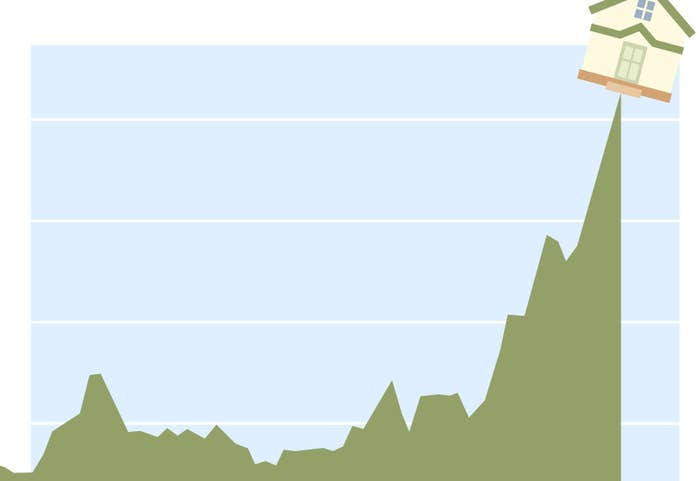
By now, I’m sure you’ve heard that buying a home has gotten astronomically more expensive in just the past 12 months as interest rates on mortgages shot up, an intentional shift stemming from the Federal Reserve’s efforts to fight record-high inflation. You may have also heard that interest rates for a 30-year mortgage are approaching 7%, rising steadily from less than 3% a year ago (with further increases predicted), and vaguely thought, Gee, that is a lot! But when you actually break down what that means for homebuyers now, it’s a dizzying, infuriating amount more.
The new rates add hundreds of dollars to prospective homebuyers’ monthly payments, and over the course of three decades that means potentially paying hundreds of thousands more than they would have just a year ago. “Seeing interest rates rise is only going to hurt affordability more for first-time homebuyers,” said Jessica Lautz, the vice president of demographics and behavioral insights at the National Association of Realtors. And these rising costs will disproportionately exclude people of color and single parents from owning, she said.
Let’s take the hypothetical example of a $400,000 home (the median price of homes this year was $440,300).
In September 2021, the average interest rate on a 30-year fixed mortgage was 2.88%.
With a 10% down payment, the monthly payment would’ve been about $1,495. Over three decades, or 360 monthly payments (which would end in 2051), that would add up to $538,047.
By comparison, with mortgage rates averaging 6.7% by the end of September 2022, that $400,000 home would cost $836,280 over 30 years. (You can try the math yourself on a mortgage calculator.) The interest rate hike means the monthly payment would be about $2,323, or $828 more than it would have been 12 months ago. Over three decades, you'd be paying more than $298,000 for the same house.
Homeowners can, of course, refinance if interest rates drop, and most of them will move before their loan is paid off in 30 years. But rising interest is tanking affordability, which was already a problem for many Americans before the pandemic. In a healthy housing market, first-time buyers make up about 40% of sales, NAR’s Lautz said, but the share has been declining, and recently it’s hovered around 29%. The last time the rate was that high was in 2008, she said, when the government introduced a first-time homebuyer tax credit (which was essentially an interest-free loan). The median monthly mortgage payment went from 17.1% of median family income in July 2021 to 24.5% this past July, according to NAR, and interest rates have only risen since then.
All these rising percentages and dollar signs mean people are getting less house for their money (as is the case in virtually all areas now, including food and gas). So unless a buyer can increase their budget to account for higher interest payments, it means looking for a house with a lower asking price and likely giving up some features and amenities in that process.
The economics of homebuying inevitably has its ups and downs. Mortgage rates also spiked in the 1970s when inflation was high, peaked at 18.5% in 1981, and remained above 10% for most of the 1980s.
Distinguishing housing needs from wants and wishes for the future is important when deciding what’s worth compromising on, said Amy Richardson, a certified financial planner with Schwab’s Intelligent Portfolios Premium service. “I can't afford what I thought I could a couple months ago,” said Richardson, who is looking to buy a home herself now and has lost a number of bids. “That's where I'm having to have that conversation with myself: Where am I going to walk away, to make sure that I don't make an emotionally charged decision that puts me in a negative financial situation?”
As a basic guideline, she said, housing should be less than 30% of gross household income (before taxes), and buyers would be wise to have money set aside — whatever they can feasibly stash away given their budget — for home maintenance and repairs that is separate from their emergency savings (which should cover three to six months of expenses in case of unemployment). “Homeownership has costs outside of just your mortgage, and I think sometimes we forget about that,” she said.
None of this is welcome news to anyone trying to buy a house now, or with other financial goals, like saving for their kids’ educations or plausibly retiring one day. So it’s no surprise that home sales are falling dramatically. Pending home sales last month fell by 24% compared to August 2021, according to NAR. People are waiting for affordability to improve; many are continuing to rent until the market turns in their favor.
As the economy remains in a period of unpredictable transition, it’s a good time for homebuyers to think about their priorities and not become too emotionally invested in homeownership if the conditions no longer make sense. “Your life is more than just a house,” Richardson said. “It's your goals and your dreams and your needs over the next couple of years.” ●
